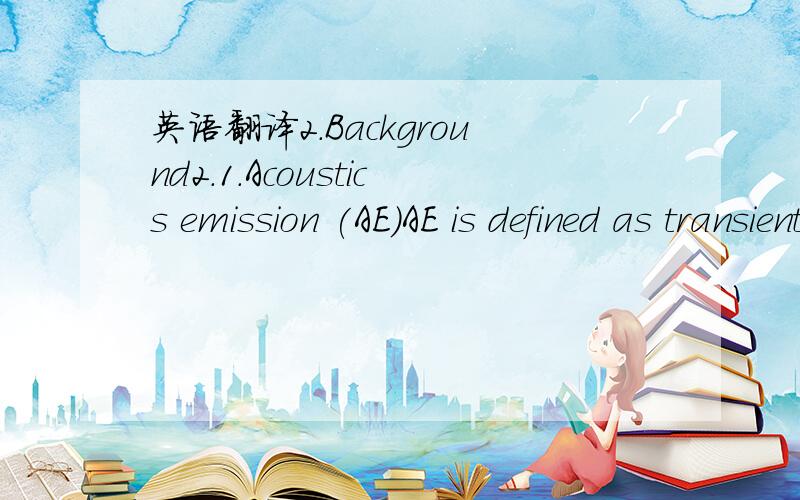英语翻译2.Background2.1.Acoustics emission (AE)AE is defined as transient elastic waves generated due to a rapid release of strain energy caused by structuralalteration in/on a solid material under mechanical or thermal stresses.Primary sources o
来源:学生作业帮助网 编辑:作业帮 时间:2024/05/02 22:19:38

英语翻译2.Background2.1.Acoustics emission (AE)AE is defined as transient elastic waves generated due to a rapid release of strain energy caused by structuralalteration in/on a solid material under mechanical or thermal stresses.Primary sources o
英语翻译
2.Background
2.1.Acoustics emission (AE)
AE is defined as transient elastic waves generated due to a rapid release of strain energy caused by structural
alteration in/on a solid material under mechanical or thermal stresses.Primary sources of AE are crack
initiation,crack propagation,plastic deformation and friction.AE was originally developed as a method of
NDT where it was used to monitor crack initiation,propagation and location.Attempts to apply this
technique to condition monitoring of rotating machinery started in the late 1960s [16].In the application to
rotating machinery monitoring,AE are defined as elastic waves generated by the interaction of two media in
relative motion.Sources of AE in rotating machinery include impacting,cyclic fatigue,friction,turbulence,
material loss,cavitation,leakage,etc.For instance,the interaction of surface asperities and impingement of
the bearing rollers over a defect on an outer race will result in the generation of AE.These emissions
propagate on the surface of the material as Rayleigh waves and the displacement of these waves is measured
with an AE sensor.
Some of the principal advantages of AE include:
(a) As AE is non-directional,one AE sensor is sufficient to perform the task compared to other techniques
such as vibration monitoring which can require information from three axes.
(b) Since AE is produced at microscopic level it is highly sensitive and offers opportunities for identifying
defects at an earlier stage when compared to other condition monitoring techniques.A typical example is
the proven ability [3] to detect the earliest stages of bearing degradation.
(c) As AE only detects high-frequency elastic waves,it is insensitive to structural resonances and typical
mechanical background noise (o20 kHz).
However,the main concern on application of the AE technique is the attenuation of the signal during
propagation and as such the AE sensor has to be as close to its source as possible.This limitation may pose a
practical constraint when applying this technique to certain rotating machinery.
英语翻译2.Background2.1.Acoustics emission (AE)AE is defined as transient elastic waves generated due to a rapid release of strain energy caused by structuralalteration in/on a solid material under mechanical or thermal stresses.Primary sources o
2.背景
2.1 AE被定义为,由机器或者热量对于一个固体物质施压产生形变,迅速放出的拉力(可能是指弹性)能量所长生的短暂的有弹性的波.AE的主要能源是裂纹的开始,裂纹的传播,橡胶的变形和摩擦.AE最初以一种NDT的形式被发展,它曾被用于监听裂缝的开始,发展和位置.从1960s气,尝试提供这种技术检测旋转机器的工作状态.在运用到旋转机检测中时,AE被定义为在相关运动中互相作用的2个介质,所发出的有弹性的波.AE 在旋转机器里的能源包括碰撞,周期性疲劳(这个我也不懂是什么),摩擦,漩涡,材料损失,气穴现象,渗漏,等等.举例说明,粗糙表面和滚轮轴承的冲击克服困难在外圈的互相作用导致产生AE.这次发射以瑞利波的方式在材料表面传播,它的唯一可以用AE传感器测量.